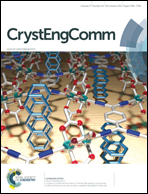Tuning the porosity through interpenetration of azobenzene-4,4′-dicarboxylate-based metal–organic frameworks†
Abstract
A series of zinc(II) or cadmium(II)-based compounds with elongated dicarboxylate and bipyridine ligands, namely {dma[Cd(μ-azdc)(μ-ac)]·xDMF}n (1), {[Cd2(μ4-azdc)(μ-azdc)(DMSO)4]·DMSO}n (2), [Cd3(μ4-azdc)3(DMF)2]n (3), {[Zn2(μ3-azdc)2(μ-pbptz)]·xDMF}n (4), and {[Zn3(μ4-azdc)3(μ-pbptz)2]·xDMF·yH2O}n (5) (where dma = dimethylammonium, azdc = azobenzene-4,4′-dicarboxylate, ac = acetate, DMF = dimethylformamide, DMSO = dimethylsulfoxide, pbptz = 3,6-bis(4-pyridyl)-1,2,4,5-tetrazine), have been synthesized under solvothermal conditions and structurally characterized by single-crystal X-ray diffraction. Crystal structures range from 2D to 3D systems according to the presence of the pbptz co-ligand, which aids the layers established by azdc ligands to increase their dimensionality. The structural diversity found in each system is the result of three factors that govern the assembling process by modulating the coordination mode of the azdc ligands: the employed solvent, counterion and metal : ligand stoichiometry. A common structural feature of these compounds is the highly open architectures achieved due to the length of the employed ligands, which favours the resulting frameworks to be interpenetrated by different degrees depending on the network topology. A careful computational analysis of the void systems of the compounds permits establishing a relationship of this phenomenon with the pore size. The photoluminescence properties of all compounds have been also investigated.


 Please wait while we load your content...
Please wait while we load your content...